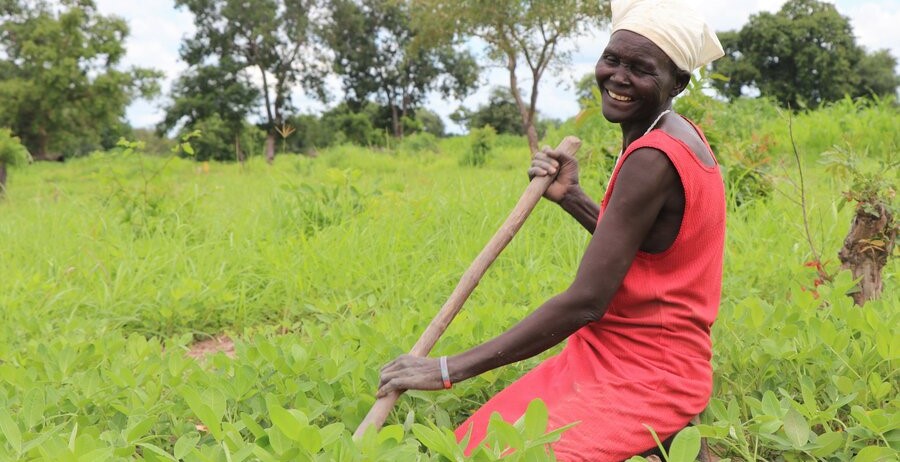In the face of climate change, our farmers and communities are increasingly becoming vulnerable to unpredictable weather, droughts, floods, and land degradation. These challenges threaten food security and livelihoods in South Sudan, where agriculture is the backbone of the economy.
Our farmers, communities, and governments have a vital role to play in adopting practices that are not only productive, but also resilient and sustainable. Climate-smart agriculture (CSA) offers a promising path forward—a way to grow our food while protecting our environment and ensuring a better future.
Climate-smart agriculture is important because it helps farmers produce more food while protecting the environment and reducing the impacts of climate change. It involves adopting practices, technologies, and policies that increase resilience—allowing farmers to withstand climate shocks—and reduce greenhouse gas emissions that contribute to global warming.
CSA is essential for our country where we face severe climate-related challenges like recurrent droughts, irregular rainfall, and flooding. In addition, land degradation and deforestation threaten the environment. This is because many farmers lack access to modern tools and techniques to cope with these changes.
By embracing CSA, we can turn these challenges into opportunities. It encourages the use of sustainable techniques that protect the land, water, and biodiversity—ensuring that agriculture remains a viable livelihood and a means to nourish our growing population.
Climate change causes unpredictable weather, droughts, floods, and other extreme events that threaten food security worldwide. Smallholder farmers, especially in developing countries like South Sudan, are among the most vulnerable. Without action, these challenges could lead to decreased harvests, increased poverty, and food shortages.
The benefits of CSA extend far beyond the farm gate. By increasing soil fertility, reducing water consumption, and sequestering carbon, CSA practices improve the overall health of our ecosystems. This, in turn, strengthens biodiversity, enhances water quality, and supports the broader well-being of communities. Furthermore, CSA promotes food security by increasing yields and making farms more resilient to climate shocks.
For decades, South Sudanese farmers have faced unpredictable rainfall, droughts, and floods, making their livelihoods precarious. However, through initiatives supporting CSA techniques, they can discover new ways to cultivate their land while adapting to the changing climate.
One example is the introduction of drought-resistant crop varieties. Farmers need to plant crops that can withstand prolonged periods of little rainfall, ensuring a harvest even during challenging times. Another critical element is water management. CSA promotes the use of rainwater harvesting techniques, enabling farmers to collect and store water for irrigation during dry seasons. This crucial adaptation is not only enhancing yields, but also bolstering the overall resilience of the agricultural sector.
The shift to CSA is not without its challenges. Farmers often lack access to information, resources, and training, making it difficult to implement new techniques. Addressing these gaps is crucial, requiring a multi-faceted approach that includes providing farmers with access to improved seeds, fertilizers, and knowledge sharing platforms. Government support and private sector collaboration are equally vital to ensure the widespread adoption of CSA practices.
Beyond the technical aspects, a cultural shift is essential to embracing CSA. Farmers need to be empowered and educated about the benefits of these techniques. Community-based learning programs, demonstration plots, and farmer-to-farmer knowledge exchange can effectively facilitate this transformation.
Many farmers across the globe have already embraced CSA practices with remarkable results. In Kenya, smallholder farmers have adopted drought-resistant crops, leading to more stable harvests. In Vietnam, integrated rice-farming systems improved resilience and income. These stories show that positive change is possible when communities come together with a shared vision.
The path toward a sustainable future requires collective effort. Governments, communities, and individuals must prioritize climate-smart agriculture as a vital strategy.
Investing in education, technology, and infrastructure will accelerate this transition and make it accessible to all.
Whether it is a farmer adopting new techniques, a consumer choosing sustainable products, or a policymaker supporting green initiatives—each action contributes to building a resilient and sustainable food system.
Climate-smart agriculture is not just a set of practices; it is a movement toward hope and resilience. It empowers us to face the challenges of climate change with confidence, transforming adversity into opportunity. By embracing CSA today, we lay the foundation for a future where food security, environmental health, and economic prosperity go hand in hand.
Let us commit to this journey—working together to nourish our world sustainably and ensure a brighter future for all.
The author, Garang Garang Adim, is an environmentalist. He can be reached at garanggarangadim@gmail.com.
The views expressed in ‘opinion’ articles published by Radio Tamazuj are solely those of the writer. The veracity of any claims made is the responsibility of the author, not Radio Tamazuj.




